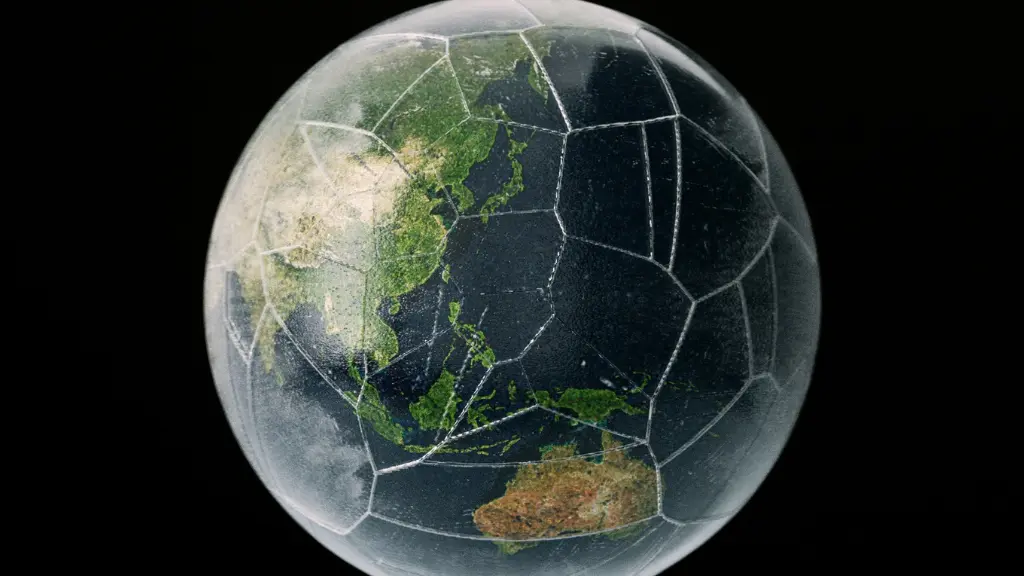

Il nucleo della Terra è una parte affascinante e misteriosa del nostro pianeta. Essendo il centro stesso della nucleo terrestre, svolge un ruolo cruciale nella struttura e nel comportamento generale del pianeta. Il nucleo è costituito da due parti distinte: il nucleo interno e il nucleo esterno.
Il nucleo interno è una sfera solida composta da ferro e nichel, con un diametro di circa 1.200 chilometri. È circondato dal nucleo esterno, che è uno strato di metallo fuso spesso circa 2.300 chilometri. Insieme, questi due strati costituiscono circa 15% del volume totale della Terra. Il nucleo è anche incredibilmente caldo, con temperature che raggiungono fino a 6.000 gradi Celsius al centro.
Gli scienziati studiano il nucleo della Terra da decenni, ma c'è ancora molto che resta sconosciuto. Tuttavia, i recenti progressi della tecnologia hanno permesso ai ricercatori di acquisire una migliore comprensione di questa misteriosa regione. In questo articolo, esplorerò il nucleo della Terra in modo più dettagliato, inclusa la sua composizione, il suo comportamento e il ruolo che svolge nel plasmare il nostro pianeta.

Il nucleo terrestre è la parte centrale del nostro pianeta, situata sotto il mantello e la crosta. È diviso in due strati: il nucleo interno solido e il nucleo esterno liquido. La composizione del nucleo terrestre è un argomento di grande interesse per gli scienziati, poiché ci aiuta a comprendere la formazione e l'evoluzione del nostro pianeta.
Si ritiene che la composizione chimica del nucleo terrestre sia principalmente composta da ferro (Fe) e nichel (Ni). Questi elementi costituiscono più di 80% della massa del nucleo, con quantità minori di altri elementi come zolfo (S), ossigeno (O) e silicio (Si). La composizione esatta del nucleo è difficile da determinare, poiché è impossibile osservarla direttamente. Tuttavia, gli scienziati sono stati in grado di trarre inferenze sulla composizione del nucleo basandosi su dati sismici ed esperimenti.
Si ritiene che il solido nucleo interno della Terra sia composto principalmente da ferro, con quantità minori di nichel e altri elementi. Si stima che abbia un raggio di circa 1.220 chilometri e una temperatura di circa 5.000 gradi Celsius. Nonostante la temperatura elevata, il nucleo interno rimane solido a causa dell'enorme pressione a cui è sottoposto.
Anche il nucleo esterno liquido del nucleo terrestre è composto principalmente da ferro e nichel, ma contiene anche elementi più leggeri come zolfo e ossigeno. Si stima che abbia uno spessore di circa 2.300 chilometri e una temperatura di circa 4.000 gradi Celsius. Il campo magnetico terrestre, che ci protegge dalle pericolose radiazioni solari, è generato dal nucleo esterno.
In conclusione, la composizione del nucleo terrestre è composto principalmente da ferro e nichel, con quantità minori di altri elementi. Il nucleo interno solido e il nucleo esterno liquido svolgono ruoli importanti nella geologia della Terra e nel campo magnetico terrestre. Sono necessarie ulteriori ricerche per comprendere appieno la composizione e il comportamento del nucleo terrestre.

Come geofisico, sono sempre stato affascinato dalla dinamica del nucleo terrestre. Il nucleo è un sistema complesso costituito da due strati distinti, il nucleo interno e il nucleo esterno. In questa sezione esplorerò i movimenti e il trasferimento di calore all'interno del nucleo.
Il nucleo della Terra è in continuo movimento. Il campo magnetico terrestre del nucleo, che ci protegge dalle pericolose radiazioni solari, è generato dal nucleo esterno. Il movimento del nucleo esterno è guidato dal calore generato dal nucleo interno e dal raffreddamento del nucleo esterno in alto. Questo movimento è noto come convezione.
Anche la rotazione della Terra gioca un ruolo chiave nel movimento del nucleo. L'effetto Coriolis fa sì che le correnti convettive ruotino in senso orario nell'emisfero settentrionale e in senso antiorario nell'emisfero meridionale. Questa rotazione crea un effetto dinamo, che genera il campo magnetico terrestre.
Il nucleo interno, d'altro canto, ruota indipendentemente dal nucleo esterno. La rotazione del nucleo interno è leggermente più veloce della rotazione della superficie terrestre, completando una rotazione completa ogni 24 ore. Questa rotazione genera una piccola quantità di energia, che si ritiene sia responsabile del mantenimento del campo magnetico del nucleo.
La scienza del nucleo terrestre è estremamente calda, con temperature che salgono fino a 6.000 gradi Celsius. Il calore è generato dal decadimento degli isotopi radioattivi e dal calore residuo della formazione della Terra. Il calore viene quindi trasferito dal nucleo interno al nucleo esterno tramite conduzione.
Il raffreddamento del nucleo esterno nella parte superiore crea un gradiente di temperatura che guida le correnti convettive. Quando il materiale caldo sale, si raffredda e ridiscende, creando un ciclo continuo di trasferimento di calore.
In conclusione, la dinamica del nucleo terrestre è un sistema complesso di movimenti e trasferimento di calore. I movimenti del nucleo sono guidati dalla convezione e dalla rotazione della Terra, mentre il calore è generato dal decadimento degli isotopi radioattivi e dal calore residuo della formazione della Terra. Comprendere la dinamica del nucleo è fondamentale per comprendere il campo magnetico terrestre e i processi che modellano il nostro pianeta.

Come scienziato della Terra, trovo affascinante lo studio del campo magnetico terrestre. Il campo magnetico è un aspetto importante del nostro pianeta e svolge un ruolo cruciale nella nostra vita quotidiana. In questa sezione, discuterò il ruolo del nucleo terrestre nella generazione e nel mantenimento del campo magnetico.
Il campo magnetico terrestre nasce dal movimento del ferro fuso all'interno del nucleo esterno. Il nucleo esterno è uno strato di ferro liquido che circonda il nucleo interno solido. Il movimento del ferro fuso genera correnti elettriche, che a loro volta producono il campo magnetico.
Il campo magnetico non è statico, ma piuttosto cambia costantemente. I poli magnetici possono muoversi e persino invertire la polarità nel tempo. Questi cambiamenti sono dovuti alle complesse dinamiche del nucleo terrestre e alle sue interazioni con il mantello e la crosta.
Le inversioni geomagnetiche sono i cambiamenti più drammatici nel campo magnetico terrestre. Durante un'inversione, il campo magnetico si indebolisce e i poli magnetici cambiano posizione. L'ultima inversione si è verificata circa 780.000 anni fa e gli scienziati stanno ancora cercando di comprendere i meccanismi che causano queste inversioni.
Una teoria è che le inversioni siano causate da cambiamenti nel flusso di ferro fuso nel nucleo esterno. Quando il flusso cambia, il campo magnetico si indebolisce e alla fine si inverte. Un'altra teoria è che le inversioni siano causate dalle interazioni tra il nucleo e il mantello.
In conclusione, il campo magnetico del nucleo terrestre è un sistema complesso e dinamico che viene generato e mantenuto dal movimento del ferro fuso nel nucleo esterno. Il campo magnetico svolge un ruolo cruciale nella nostra vita quotidiana, dalla guida delle bussole alla protezione dalle radiazioni solari dannose. Comprendere il ruolo del nucleo nel magnetismo terrestre è un'importante area di studio per gli scienziati della Terra.

Come scienziato della Terra, trovo affascinante lo studio del nucleo terrestre. Il nucleo terrestre è la parte più interna del nostro pianeta, costituita da un nucleo interno solido e da un nucleo esterno liquido. Il nucleo costituisce circa 15% del volume della Terra e 32% della sua massa. Nonostante la sua importanza, studiare il nucleo terrestre è un compito arduo a causa della sua inaccessibilità.
Uno dei metodi principali utilizzati per studiare il nucleo terrestre è l'analisi delle onde sismiche. Le onde sismiche sono onde di energia che viaggiano attraverso l'interno della Terra e possono fornire informazioni preziose sulle proprietà del nucleo terrestre. Analizzando i tempi di percorrenza e le ampiezze delle onde sismiche, gli scienziati possono dedurre la densità, la temperatura e la composizione del nucleo terrestre.
Un altro metodo utilizzato per studiare il nucleo terrestre è la simulazione computazionale. Questa prevede l'uso di modelli al computer per simulare il comportamento del nucleo terrestre in diverse condizioni. Variando parametri come temperatura, pressione e composizione, gli scienziati possono ottenere informazioni sulla dinamica del nucleo terrestre e su come influenza il campo magnetico terrestre.
In conclusione, studiare il nucleo terrestre è un compito complesso e impegnativo che richiede l'uso di molteplici metodi e tecniche. Attraverso l'analisi delle onde sismiche e la simulazione computazionale, gli scienziati stanno acquisendo una migliore comprensione del nucleo terrestre e del suo ruolo nel plasmare il pianeta su cui viviamo.

Come persona che ha studiato il nucleo terrestre, posso dire con sicurezza che il nucleo è una delle parti più affascinanti e importanti del nostro pianeta. Si trova al centro stesso della Terra ed è costituito da due nuclei in strati terrestri: il nucleo interno e il nucleo esterno.
Il confine tra il nucleo terrestre e il mantello è noto come confine nucleo-mantello. Si trova a circa 2.900 chilometri sotto la superficie terrestre. Il confine è caratterizzato da un forte aumento della densità e da un cambiamento nel comportamento delle onde sismiche che lo attraversano.
Il confine nucleo-mantello è un'area di studio molto importante per geologi e sismologi. Si ritiene che il confine svolga un ruolo cruciale nel movimento delle placche tettoniche e nella formazione dell'attività vulcanica. Si ritiene inoltre che il confine sia responsabile della generazione del campo magnetico terrestre.
Anche le interazioni tra il nucleo e la crosta sono molto importanti. Il calore del nucleo terrestre guida il movimento delle placche tettoniche, che a loro volta modellano la superficie terrestre. Il nucleo gioca anche un ruolo nella formazione delle montagne, poiché il movimento delle placche tettoniche può causare la deformazione e la piegatura della crosta.
Inoltre, il campo magnetico del nucleo terrestre è responsabile della protezione della Terra dagli effetti dannosi del vento solare e delle radiazioni cosmiche. Senza questo campo magnetico, la vita sulla Terra sarebbe molto più difficile, se non impossibile.
Nel complesso, il nucleo terrestre è una parte cruciale dell'interno della Terra. Le sue interazioni con il mantello e la crosta sono responsabili di molti dei processi geologici che modellano il nostro pianeta. Attraverso studi e ricerche continui, possiamo acquisire una migliore comprensione del nucleo e del suo ruolo nella storia e nel futuro del nostro pianeta.

Come persona che ha studiato il nucleo del pianeta Terra, posso affermare con sicurezza che ha un'influenza significativa sui fenomeni di superficie. In questa sezione, discuterò due modi principali in cui il nucleo influenza la superficie terrestre: l'attività vulcanica e i movimenti tettonici.
Il nucleo terrestre svolge un ruolo cruciale nella generazione dell'attività vulcanica. Il magma, che è roccia fusa che si trova sotto la superficie terrestre, è creato dalla fusione delle rocce nel mantello e nella crosta. Questa fusione è causata dalle alte temperature e pressioni che esistono nelle profondità della Terra, che sono in ultima analisi generate dal calore rilasciato dal nucleo.
Il nucleo terrestre influenza anche la composizione del magma. Il nucleo è composto principalmente da ferro e nichel, e si pensa che questi elementi siano la fonte del ferro e del nichel che si trovano nel magma. Inoltre, il campo magnetico del nucleo può influenzare il movimento del magma, che a sua volta può influenzare la posizione e l'intensità delle eruzioni vulcaniche.
Il nucleo terrestre svolge anche un ruolo significativo nei movimenti tettonici, che sono i movimenti delle placche crostali della Terra. Si pensa che il calore del nucleo sia il motore principale di questi movimenti, poiché provoca correnti convettive nel mantello. Queste correnti, a loro volta, guidano il movimento delle placche crostali.
Il nucleo terrestre influenza anche la composizione e la resistenza delle placche crostali. Il calore generato dal nucleo rende le rocce del mantello e della crosta più duttili, il che significa che si deformano più facilmente. Ciò può portare alla formazione di faglie e fratture nelle placche crostali, che alla fine possono provocare terremoti.
In conclusione, il nucleo terrestre ha un'influenza significativa sui fenomeni superficiali, in particolare sull'attività vulcanica e sui movimenti tettonici. Comprendere il ruolo del nucleo in questi processi è fondamentale per prevedere e mitigare gli effetti dei disastri naturali come le eruzioni vulcaniche e i terremoti.

Come geologo, trovo che il nucleo terrestre sia un argomento affascinante. Non solo influenza il campo magnetico del pianeta, ma ha anche un impatto sugli oceani. In questa sezione, discuterò la relazione tra il nucleo terrestre e gli oceani.
Il nucleo terrestre genera calore, che viene trasferito alla superficie attraverso la convezione. Questo calore guida la circolazione termoalina, responsabile del movimento dell’acqua negli oceani. La circolazione termoalina è guidata dalle differenze di temperatura e salinità, che creano gradienti di densità nell’oceano.
L'acqua calda dell'equatore scorre verso i poli, dove si raffredda e affonda nel fondo dell'oceano. Quest'acqua fredda rifluisce poi verso l'equatore, completando la circolazione. Questo processo svolge un ruolo cruciale nella regolazione del clima del nucleo terrestre distribuendo il calore attorno al pianeta.
Il nucleo terrestre ha anche un impatto sui cambiamenti del livello del mare. L'attrazione gravitazionale della Luna e del Sole causa le maree, che possono essere influenzate dai cambiamenti nel campo magnetico terrestre. Il campo magnetico è generato dal movimento del ferro fuso nel nucleo terrestre, che può essere influenzato da fattori esterni come le tempeste solari.
I cambiamenti nel livello del mare possono anche essere causati dallo scioglimento dei ghiacciai e delle calotte polari, che è influenzato dal nucleo terrestre. Lo scioglimento del ghiaccio può causare cambiamenti nella distribuzione della massa sulla superficie del nucleo terrestre, che può influenzare la rotazione del pianeta e il campo gravitazionale.
In conclusione, il nucleo terrestre svolge un ruolo significativo nel funzionamento degli oceani. La circolazione termoalina e i cambiamenti del livello del mare sono solo due esempi della complessa relazione tra il nucleo terrestre e gli oceani. Come geologo, trovo che questa relazione sia un argomento affascinante per ulteriori studi.

Come ricercatore in scienze del nucleo terrestre, sono entusiasta delle future possibilità di esplorazione e scoperta. C'è ancora così tanto che non sappiamo sul funzionamento interno del nostro pianeta e credo che la ricerca e l'esplorazione continue porteranno a nuove intuizioni e a una comprensione più profonda del nucleo terrestre.
Un ambito di particolare interesse è lo studio delle onde sismiche. Analizzando il modo in cui le onde sismiche viaggiano attraverso il nucleo terrestre, possiamo ottenere preziose informazioni sulla composizione e la struttura del nucleo. La ricerca in corso in questo settore potrebbe portare a nuove scoperte sulle proprietà del nucleo e sui processi che avvengono al suo interno.
Un’altra strada promettente per la ricerca futura è l’uso della modellazione e simulazione computerizzata. Creando modelli dettagliati del nucleo terrestre, possiamo simulare il comportamento di diversi materiali e testare varie ipotesi sui processi del nucleo. Questo approccio ha già prodotto risultati entusiasmanti e credo che i continui investimenti in questo settore porteranno a ulteriori progressi.
Inoltre, credo che ci sia ancora molto da imparare dall'esplorazione diretta del nucleo terrestre. Sebbene si tratti di un compito arduo, stanno emergendo nuove tecnologie e tecniche che potrebbero renderlo possibile. Ad esempio, lo sviluppo di tecniche e materiali di perforazione avanzati potrebbe consentirci di penetrare più in profondità nella crosta terrestre e raggiungere il nucleo. Allo stesso modo, i progressi nella robotica e nel telerilevamento potrebbero consentirci di esplorare il nucleo senza entrarvi fisicamente.

Nel complesso, sono ottimista riguardo al futuro di Nucleo terrestre scienza e il potenziale per nuove scoperte e intuizioni. Continuando a investire nella ricerca e nell’esplorazione, possiamo approfondire la nostra comprensione del nostro pianeta e delle forze che lo modellano. Vedi altri articoli come questo cliccando qui: Cole Parmer Antylia: una recensione dettagliata.